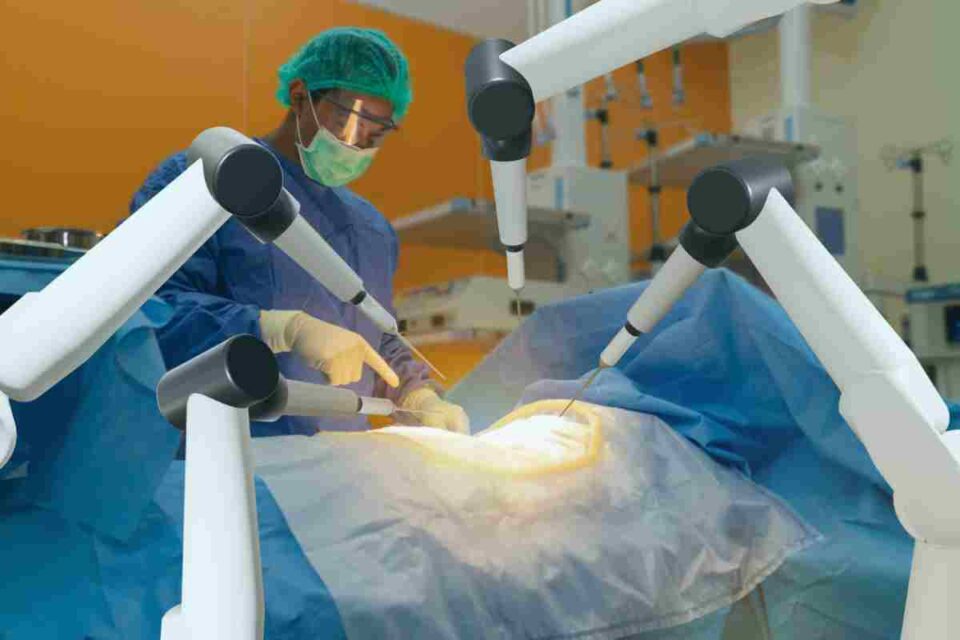Prostate cancer through robotic surgery: Robotic radical prostatectomy (RRP) is today the treatment of choice for prostate cancer with curative intent, as recommended by the International Societies of Urology. Treatment is based on removing the prostate, part of the tissue surrounding it, and the seminal vesicles. It a complex surgery and requires a high level of technical precision to minimize the risk of sequelae if the best results are to be obtained.
The prostate is surrounded by nerves and structures that important for the patient to have normal urinary and sexual function that are tried to preserve as much as possible without compromising the oncological result of the surgery.
The quality of surgery is essential to achieve satisfactory results both in cancer control and in avoiding sequelae that can significantly and permanently affect patients’ quality of life. Accuracy is the most crucial factor in obtaining the best results. The precision determined by the surgeon’s experience and the tools necessary to perform it. Today, the da Vinci Xi robot is the latest technology for performing this type of surgery.
Also read: How is Dry Skin Dissimilar From Dehydrated Skin?
Table of Contents
How Does the Surgeon’s Experience Influence The Success of The Surgery?
One of the most significant essential aspects is the surgeon’s experience in handling the da Vinci robot. This experience is possibly one of the most relevant and has the most influence on the success of the surgery and the reduction of complications and possible postoperative sequelae.
For this reason, the surgeon must have the most excellent possible experience in the management of robotic surgery. At Sutro, we have extensive experience in the management and use of robotic prostate surgery.
What are The Advantages of Robotic Surgery for The Treatment of Prostate Cancer?
Robotic surgery has significant and essential benefits to patients contribute; its advantages are unquestionable, allowing a 3D vision and augmented × 10, allowing greater accuracy throughout surgery and in this way to appreciate more fully all tissues. It is as if we were inside the body with all the advantages of minimal invasion.
The tools and instruments used have a rotation of more than 360 degrees. So the surgeon has excellent freedom of movement. More significant than that of the human hand – that increases the possibilities of suturing and dissection during surgery. In turn, they are tiny, so the precision of each cut increases, allowing the surgeon to go slowly and step by step, reducing the aggression to healthy tissues and preserving all the desired structures, performing microsurgery and going nerve to nerve and glass by glass. Thanks to this, the side effects of prostatectomy significantly reduced, increasing the chances of sexual potency and postoperative urinary continence.
In turn, as there are no tremors – unlike, for example, laparoscopy – the image is static, offering the same quality of vision, thereby increasing the surgeon’s ability to concentrate.
These advantages provided by robotic surgery are significant since they benefit patients who undergo surgery for prostate cancer. Mainly, there are two factors: minimal aggression on the body and maximum precision when removing the prostate.
Surgery Indicated for all Prostate Cancer Patients?
When prostate cancer diagnosed, the intervention can carried out as long as the tumor is within the prostate; in expert hands, it can evaluate the performance of surgery even in more advanced and high-risk tumors. These patients must evaluated individually. Since the possibility of surgery depends on many factors such as the type of tumor, its extension, the age of the patient
Robotic surgery, together with the surgeon’s experience, significantly reduces the possible complications of the surgery.
What Are The Contraindications to Surgery if Prostate Cancer Diagnosed?
When diagnosing prostate cancer, one should evaluate the most indicated treatment for each patient individually; there is no absolute contraindication not to perform a prostatectomy. Whether or not the intervention achieved will depend on several factors that must evaluate according to each patient.
What do we Expect When we Intervene in a Radical Prostatectomy Patient? How are the Results of the Surgery?
The ideal result would achieve five objectives: avoiding tumor recurrence, urinary continence, preservation of sexual potency, negative surgical margins, and absence of complications.
Robotic surgery currently represents the option with the highest probability. Achieving the five objectives, given its precision and advantages to the patient.
What Complications does Robotic Surgery Have?
Robotic radical prostatectomy is a very safe technique in expert hands. Complications are very infrequent, provided that the urologist who performs the intervention has extensive experience in the management of robotic surgery.
What Care Should the Patient Follow After the Intervention?
The patient was admitted the same day of surgery. In most cases, the postoperative period passes without incident and can be discharged with a urinary catheter in approximately 48 hours. Being asymptomatic and without requiring special postoperative care.
The urinary catheter will generally removed ten days after surgery. For more information on radical prostatectomy, see a urologist.

